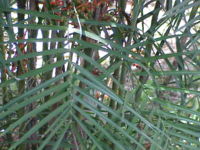Chamaedorea
| Standard Cyclopedia of Horticulture |
|---|
|
Chamaedorea (Greek, dwarf and gift). Palmaceae. Spineless, erect, procumbent or rarely climbing usually pinnatisect or pinnate palms. Trunks solitary or cespitose, slender or reed-like: lvs. simple, bifid at the apex or variously equally-pinnatisect; lobes broad or narrow, straight or oblique, acuminate, plicate-nerved, usually callous at the base, the basal margins folded back or recurved; petiole usually cylindrical; sheath tubular, oblique at the throat: spadices among or below the lvs., simple or paniculately branched; spathes 3 or many, often appearing much below the lvs., alternate, sheathing, elongated, split at the apex, membranous or coriaceous, usually persistent; pistillate fls. very small, solitary, in small pits in the spadix: fr. small, of 1-3 globose or oblong-obtuse carpels, coriaceous or fleshy.—Species about 60. Mex. to Panama. G.C. II. 23:410, and Dammer's articles inG.C.III. 38:42-44 (1905), and 36:202, 245 (1904). Peat or leaf- mold, loam and sand in equal parts, with a little charcoal added, form the best soil. The species common in cultivation are quick- growing. They are well suited for planting out in greenhouse borders. The sexes are on different plants; therefore several should be planted in a group if the handsomely colored fruit is desired. All of the kinds require warm temperature in winter. Increased from seeds. Of the many species, only a few appear in the American trade. (G. W. Oliver.) C. atrovirens, Mart. St. bamboo-like, stiff and simple, about 9 ft. high: lvs. bright green, spreading, about 2½ ft. long. Mex. Not common in the trade but grown in fanciers' collections. — C. bambusoides, Hort.. Sts. tufted, thin, reed-like, with feathery light green lvs. Honduras. — C. formosa, Hort. A showy pinnate-lvd. palm of unknown botanical status. G.C. II. 5:724. — C. geonomaeformis, Wendl. St. 4 ft.: lvs. simple, deeply cut, about 9 in. long: spadix from among the lvs. long-pendulous. Guatemala. Gn. 24, p. 244; 30, p. 593.— There are said to be a number of unidentified species scattered about Calif. Jared G. Smith. N. Taylor.
|
| Chamaedorea {{{status}}} Fossil range: {{{fossil_range}}}
| ||||||||||||||||||||||||||||||||||||||||||||||||||||||||||||||||||
|---|---|---|---|---|---|---|---|---|---|---|---|---|---|---|---|---|---|---|---|---|---|---|---|---|---|---|---|---|---|---|---|---|---|---|---|---|---|---|---|---|---|---|---|---|---|---|---|---|---|---|---|---|---|---|---|---|---|---|---|---|---|---|---|---|---|---|
 Chamaedorea seifrizii | ||||||||||||||||||||||||||||||||||||||||||||||||||||||||||||||||||
| Plant Info | ||||||||||||||||||||||||||||||||||||||||||||||||||||||||||||||||||
| ||||||||||||||||||||||||||||||||||||||||||||||||||||||||||||||||||
| Scientific classification | ||||||||||||||||||||||||||||||||||||||||||||||||||||||||||||||||||
| ||||||||||||||||||||||||||||||||||||||||||||||||||||||||||||||||||
| [[{{{diversity_link}}}|Diversity]] | ||||||||||||||||||||||||||||||||||||||||||||||||||||||||||||||||||
| {{{diversity}}} | ||||||||||||||||||||||||||||||||||||||||||||||||||||||||||||||||||
| Binomial name | ||||||||||||||||||||||||||||||||||||||||||||||||||||||||||||||||||
| {{{binomial}}} | ||||||||||||||||||||||||||||||||||||||||||||||||||||||||||||||||||
| Trinomial name | ||||||||||||||||||||||||||||||||||||||||||||||||||||||||||||||||||
| {{{trinomial}}} | ||||||||||||||||||||||||||||||||||||||||||||||||||||||||||||||||||
| Type Species | ||||||||||||||||||||||||||||||||||||||||||||||||||||||||||||||||||
| {{{type_species}}} | ||||||||||||||||||||||||||||||||||||||||||||||||||||||||||||||||||
| {{{subdivision_ranks}}} | ||||||||||||||||||||||||||||||||||||||||||||||||||||||||||||||||||
| [[Image:{{{range_map}}}|{{{range_map_width}}}|]] | ||||||||||||||||||||||||||||||||||||||||||||||||||||||||||||||||||
| Synonyms | ||||||||||||||||||||||||||||||||||||||||||||||||||||||||||||||||||
| {{{synonyms}}} |
Chamadorea is a genus in the family Arecaceae. It contains Chamadorea elegans, also known as Neanthe Bella palm, a popular houseplant. Bold text